Retention isn’t just about saving accounts that are at risk.
It’s about proactively engaging customers to create long-term partnerships and helping them get more value out of your product.
Unfortunately, some B2B brands focus heavily on acquisition, but neglect to invest in the personalized communication needed to keep existing customers engaged.
So they’re spending all their time filling up a leaky bucket.
Instead, retention marketing should be as targeted and intentional as acquisition, especially if you’re selling SaaS, where retention is a critical revenue driver.
This playbook will detail how Marketing can help Customer Success (CS) drive more effective retention marketing campaigns that reduce churn and turn customers into ambassadors.
Retention is not a Customer Success job, it's an organization-wide priority
In many B2B companies, the revenue team is chasing acquisition, and retention is a second thought.
Leadership might be concerned with churn and banging the retention drum, but at the practical level, there’s an alignment problem.
Sales is focused on closing new accounts. Marketing is focused on building the funnel. Retention is thought of as something only Success is concerned with.
That’s a missed opportunity.
Instead, retention should be an organization-wide priority.
As far back as when the company is aligning on its ICP, we need to make retention and long-term customer growth the priority. Tenure, LTV, and MRR are the metrics that help us determine our ICP, not just a company’s propensity to buy.
Sales must focus on bringing in accounts with the strongest use cases and the highest propensity to grow with your product over time. Marketing should support CS efforts with churn prevention programs and proactive customer education campaigns.
The examples below will focus on the latter: how Marketing can support retention, specifically using contact-level ads.
Contact-level advertising allows you to stay connected with the individuals who influence renewal decisions. It gives you the ability to deliver personalized messaging that reinforces the value of your product, highlights new features, and addresses potential concerns before they escalate.
Ads—or any channel for that matter—aren’t a replacement for a strong Customer Success team.
Instead, Marketing should use ads to support and align with CS, helping them cut through the channels that aren’t getting the same mileage they used to.
Here’s how:
Retention marketing ad examples and ideas
Evergreen campaigns
Churn happens when customers feel disconnected, unsupported, or unaware of the value your product is delivering.
But if you’re educating them on how to get the most out of your product, and they’ve got your tool deeply embedded into their daily workflows, they’re much less likely to cancel their subscription.
There’s an easy win here.
You’re probably already helping prospects understand the value of your product and how it can help them solve core challenges.
You just need to repurpose that acquisition-focused content and get it in front of your current customers.
Here are a few ideas on how to execute that.
Repurposing educational content
Playbooks, webinars, podcasts, step-by-step guides, feature demos, and use case content are all prime examples of existing assets that you can repurpose to support your CSMs.
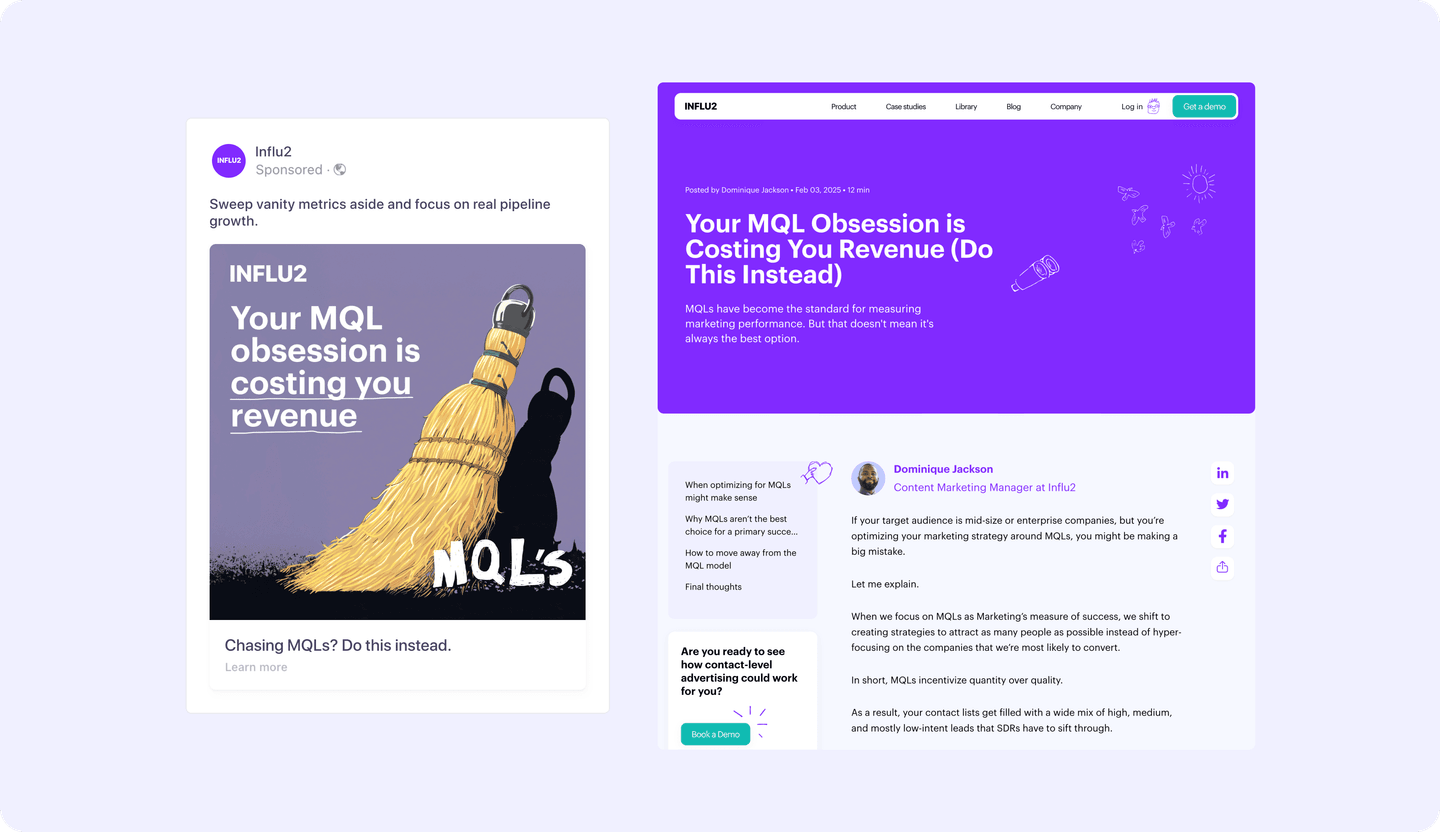
For example, we can (and probably will) use this very playbook to educate both prospective buyers and existing customers on how to improve their retention marketing programs.
You may not even have to do any repurposing at all. It can simply be a case of adding key stakeholders (that CS helps you identify) to an existing ad cohort.
Promoting event attendance
Industry events that you’re attending or hosting are not only an acquisition play—they’re also a great opportunity to get some real face time with existing customers and forge a more personal relationship.
Encourage your existing customers to attend by adding them to your existing event promotion ad program.
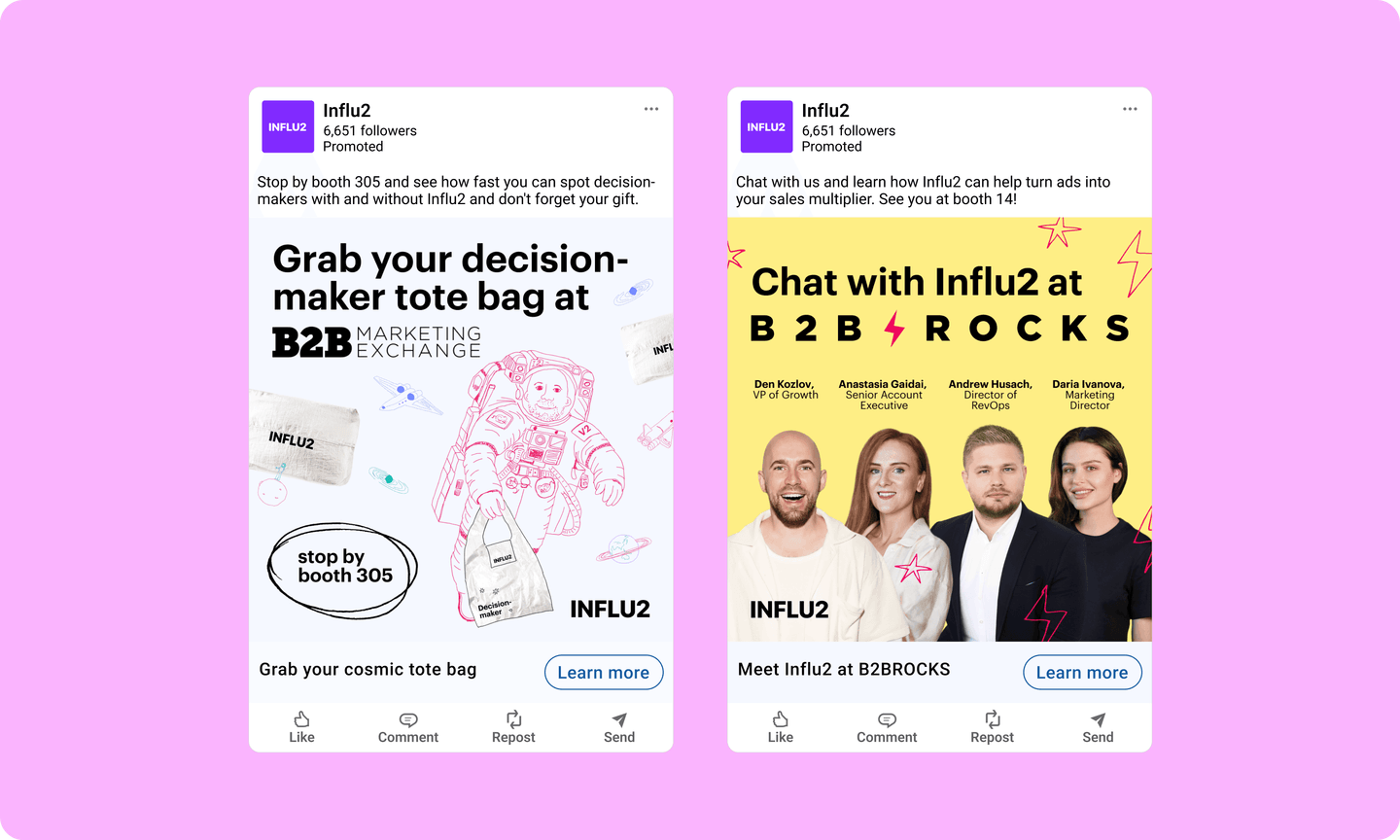
Churn prevention
When a customer starts showing signs of churn(e.g. a major decline in usage or a sudden drop in the account’s CSAT score), it’s an all-hands-on-deck moment.
Here’s how Marketing can help CS reduce churn.
Combatting a declining CSAT score
When a customer’s CSAT moves from green to yellow, their CSM can schedule a call to dig deeper and figure out what needs to be done to improve their overall satisfaction.
Marketing can help them get that call booked by providing air cover with personalized ads.
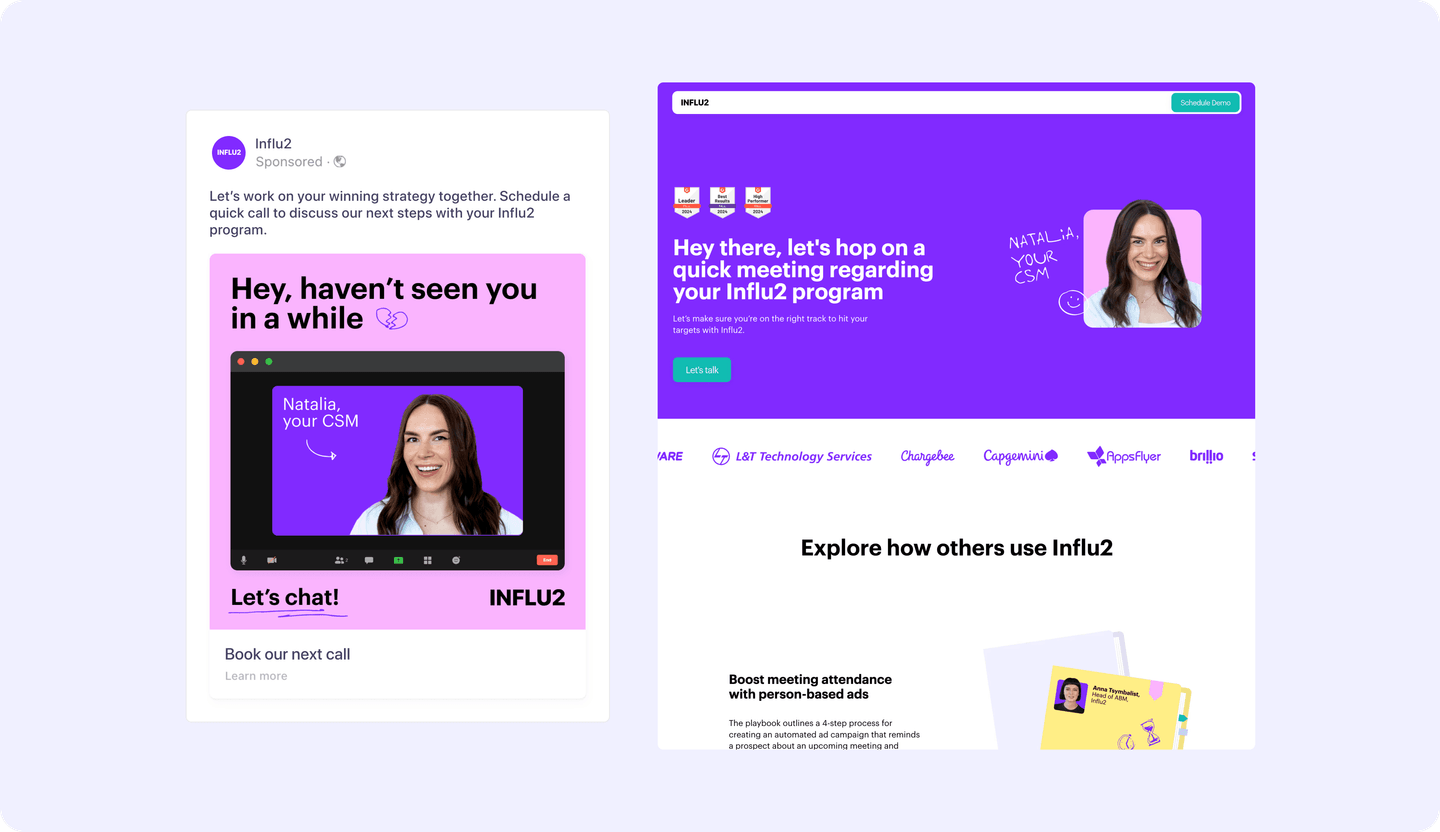
Increasing account activity
The most important churn signals are always usage-related.
Drops in feature utilization, average session duration, and weekly average user logins are all signs that CS and Marketing need to team up to increase usage.
Where overall usage is slowly declining, a gentle nudge to log in and a reminder of the value your product delivers might do the trick.
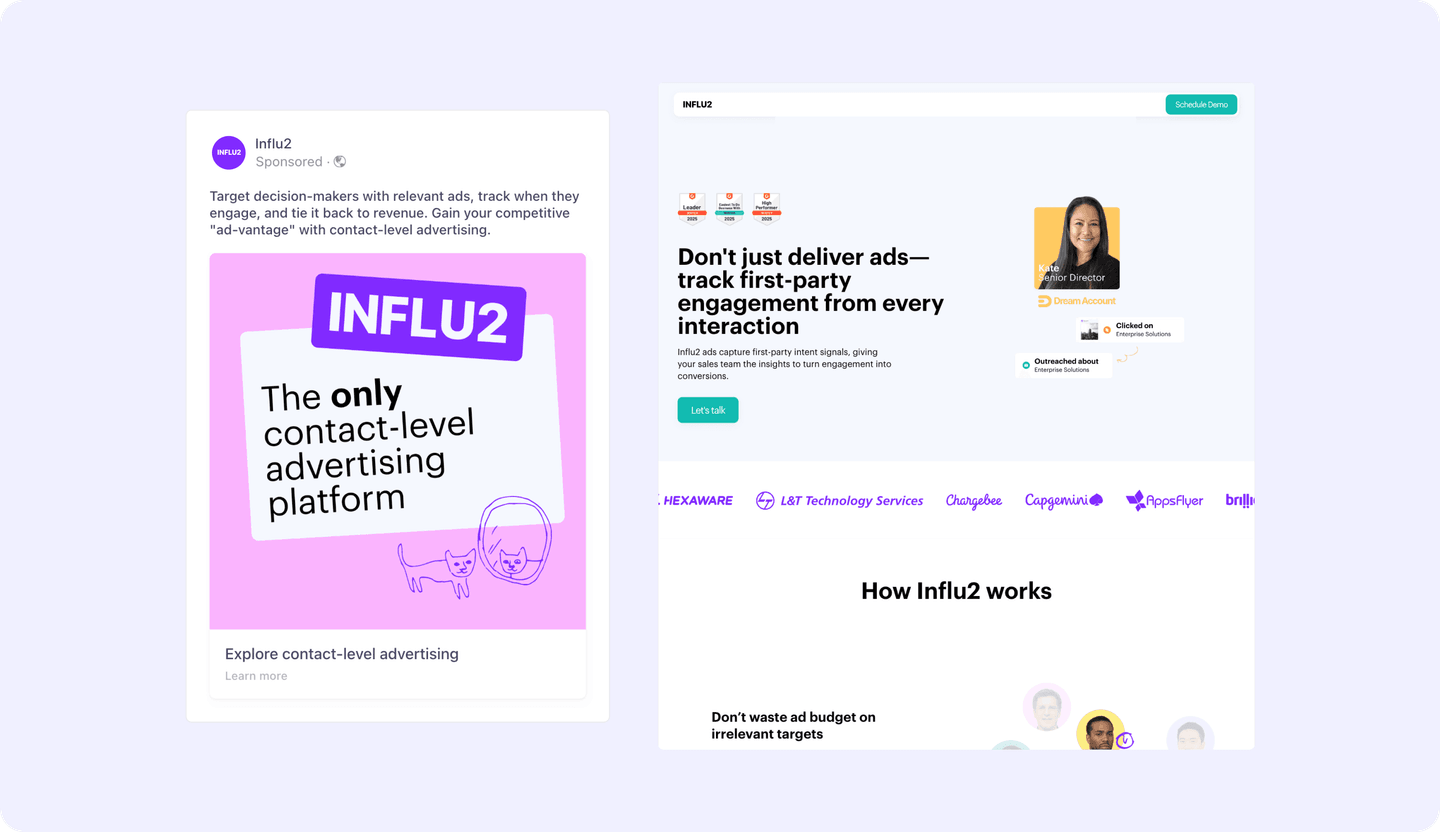
Couple this with an ad prompting the user to jump on a call with their CSM to provide even more personalized value.
If usage of a specific feature is on the decline, it might be because the user doesn’t fully understand how to get the most out of it.
Marketing can support here by distributing playbooks, tutorials, and guides.
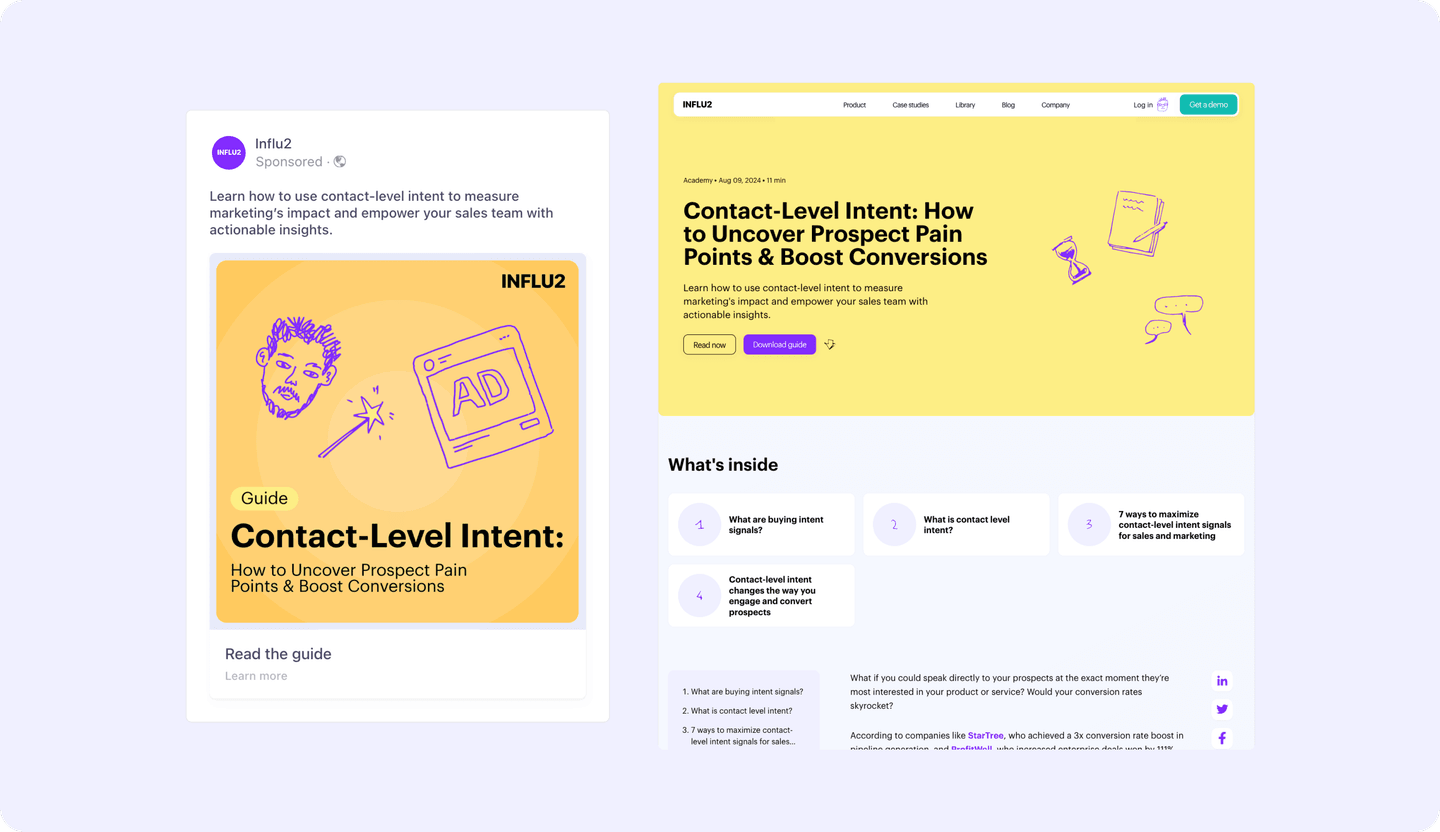
By supporting with air cover via contact-level ads, Marketing can expand Success’ bandwidth.
A CSM can’t very well get on a phone call with every single user within an account to guide them through how to use a feature, but Marketing can help reach these users with educational content that promotes greater usage.
Proactive retention
Retention isn’t just about preventing churn. It's about setting up the necessary parameters so that churning isn’t even a thought on the customer’s mind.
Here are a few ways that Marketing can help increase adoption, engage stakeholders, and drive customer advocacy.
Encouraging feature adoption
Use your product analytics tool to understand feature adoption on a per-user basis, and then team up with CS and Product to run feature-specific adoption campaigns.
You might identify that when people use a specific feature, they’re much less likely to churn.
Your contact-level ad sequence might look like this:
- Share a feature walkthrough video.
- Promote a how-to guide or playbook.
- Invite the user to book a call with their CSM.
Launching a customer advocacy program
Turning customers into advocates—getting them to engage in case studies, reviews, and referrals—is a compound win.
Not only are you capturing social proof to use in your acquisition campaigns, but you’re influencing retention by leveraging the consistency principle.
When people state their affinity for a brand publicly (by leaving a positive review or taking part in a case study), they feel compelled to be consistent with those statements, enhancing customer loyalty.
Here’s a scrappy way to launch a customer advocacy program using contact-level ads:
1. Work with your CSMs to identify who your champions are within each account, then build an ad cohort and import the audience from Salesforce.
2. Run contact-level ads asking your champions to leave a review on G2.
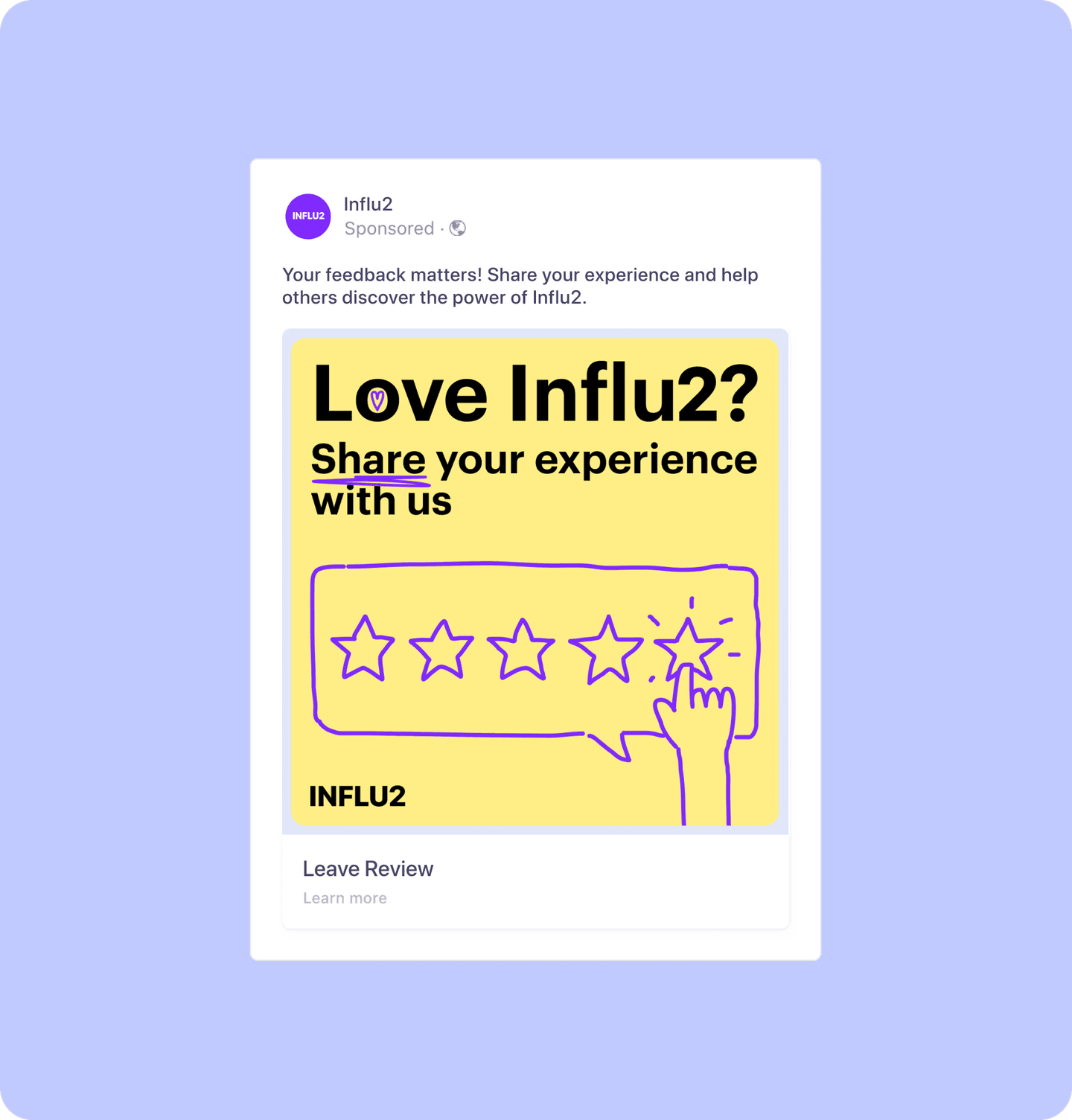
3. Analyze the sentiment of those reviews to understand who your biggest advocates are, then team up with the CSM on the account to ask for a case study.
Promoting a new feature launch
Whenever you drop a new feature, adoption among existing customers is priority number one.
CS and Product Marketing will team up to promote the feature via traditional channels like email.
Marketing can mirror these efforts with an ad journey targeting likely users with educational resources.
For instance, we recently held a webinar to launch our new Sales & Marketing Alignment Dashboard. As part of the promotion, we ran contact-level ads (with Influ2) targeting customers who’d benefit from the feature.
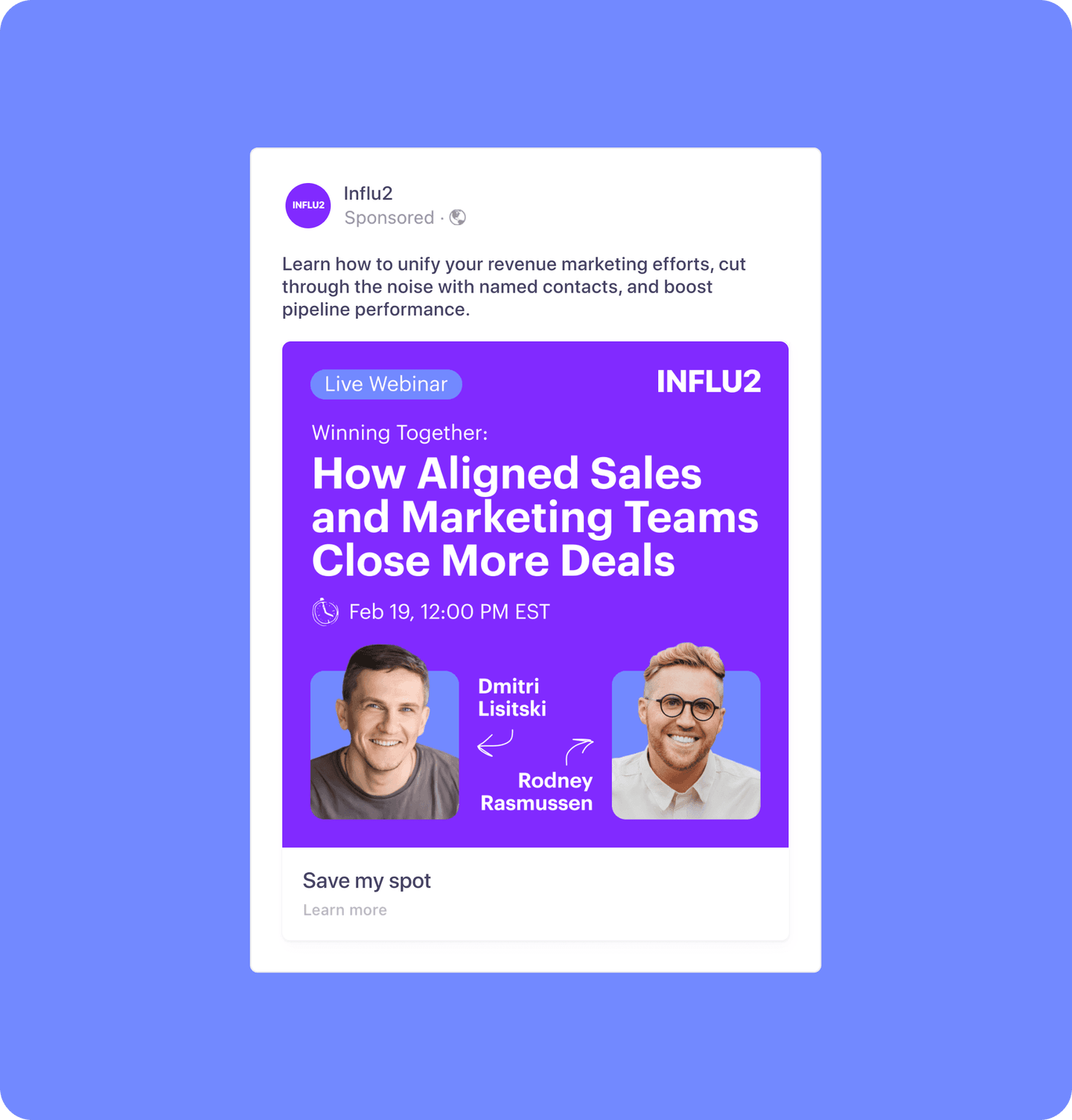
Getting buy-in from a new stakeholder
It's always a churn risk when an important account stakeholder is replaced, and the CSM will want to be proactive in their outreach to secure their buy-in.
Marketing can support this with ads that promote:
- A personalized CSM introduction and request to meet
- Trust-based content that enforces positive brand associations prior to stakeholders' first meeting with the CSM
- Educational product content relevant to the stakeholder’s role and persona
- Case studies from relevant industries
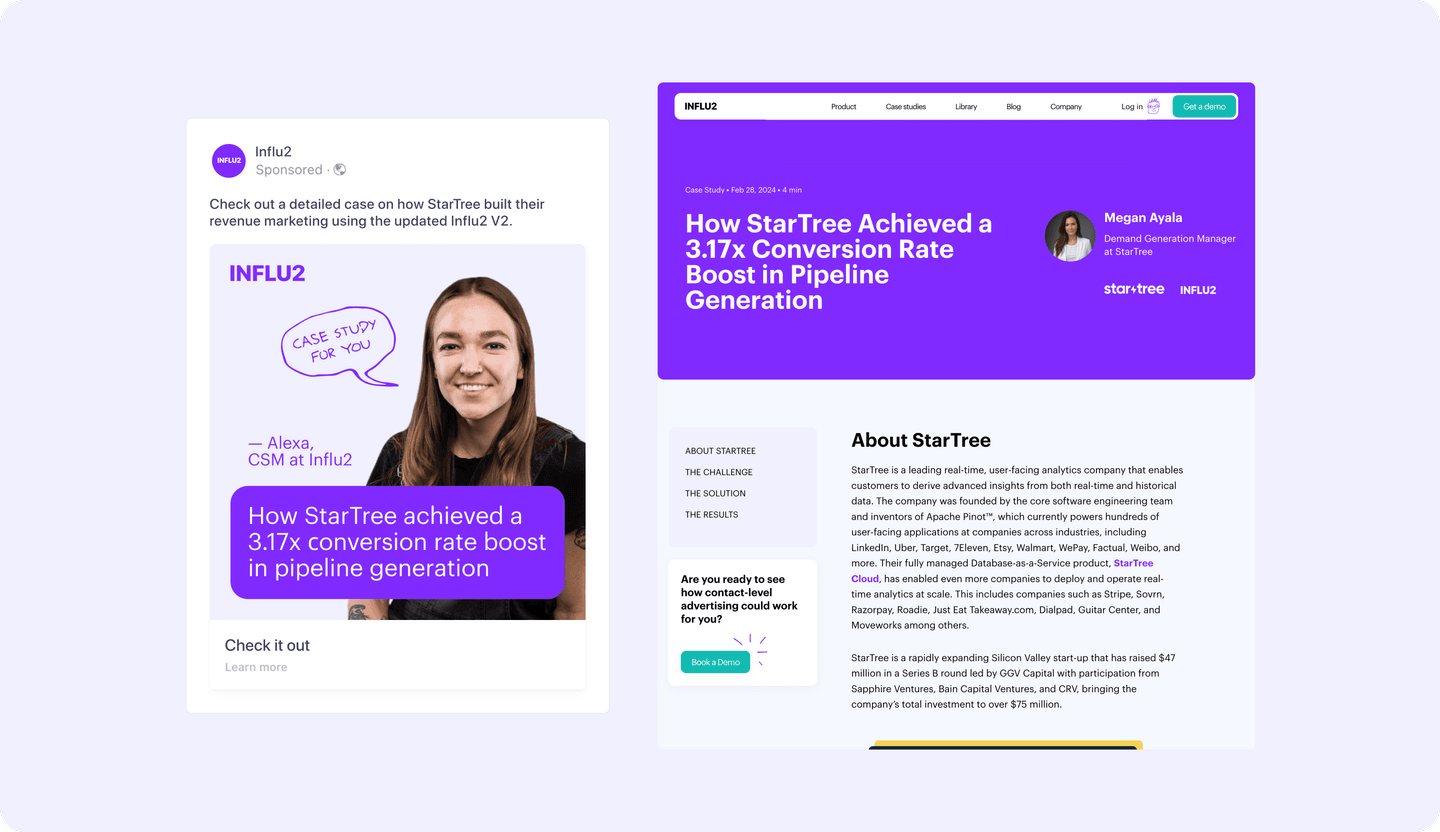
Onboarding
When designing an ad journey for the new customer onboarding process, you want to make sure your creative aligns with the CS’s onboarding process and helps them achieve the key goals and milestones they’ve already established.
This entire journey can be automated using updates in your CRM as a trigger.
Introducing the CSM
Marketing can help improve the Sales to CS handoff by literally putting a face to the name.
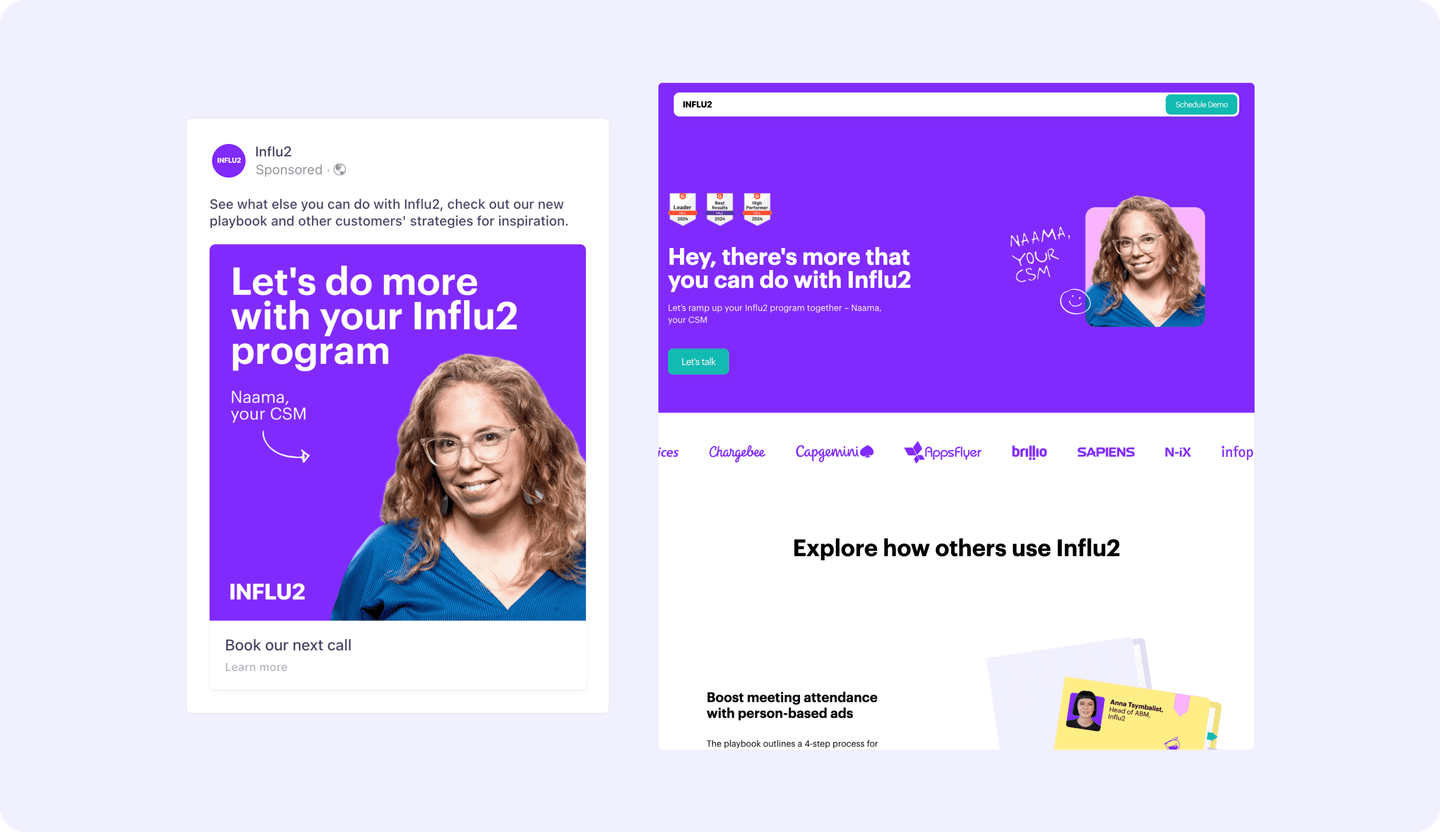
The trigger for this ad would be when the deal is marked as “Closed/Won” in your CRM and the account has been assigned to a Customer Success Manager (CSM).
Influencing onboarding meeting attendance
Just as prospects ghost your AEs, onboarding meeting no-shows are also a problem for CSMs.
Marketing can help increase meeting attendance with personalized air cover.
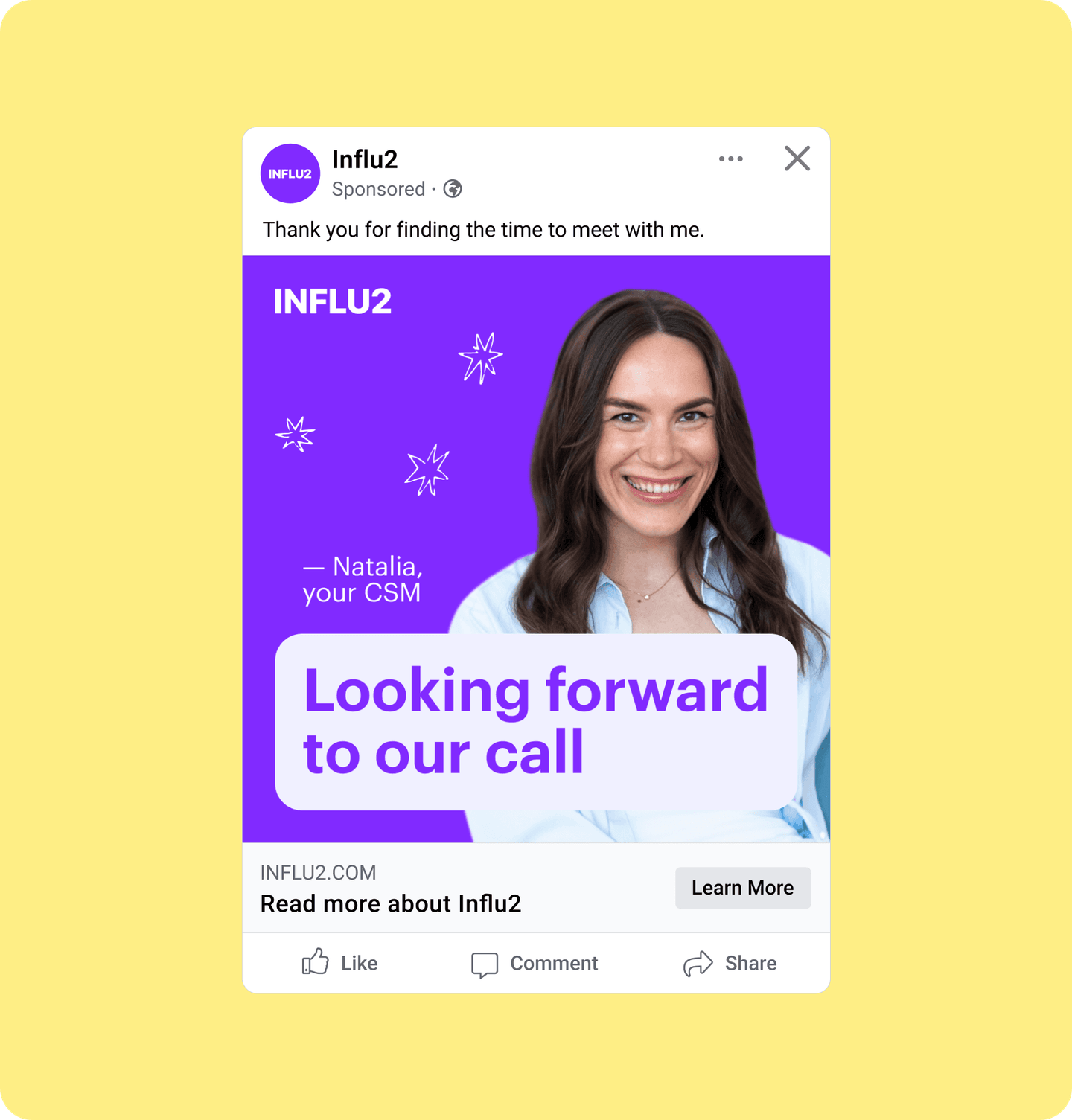
In this case, the trigger would be when the onboarding meeting is scheduled.
If, for whatever reason, the customer can’t make it, the CSM would add a no-show status, which would trigger a second ad set with the goal of having the customer reschedule.
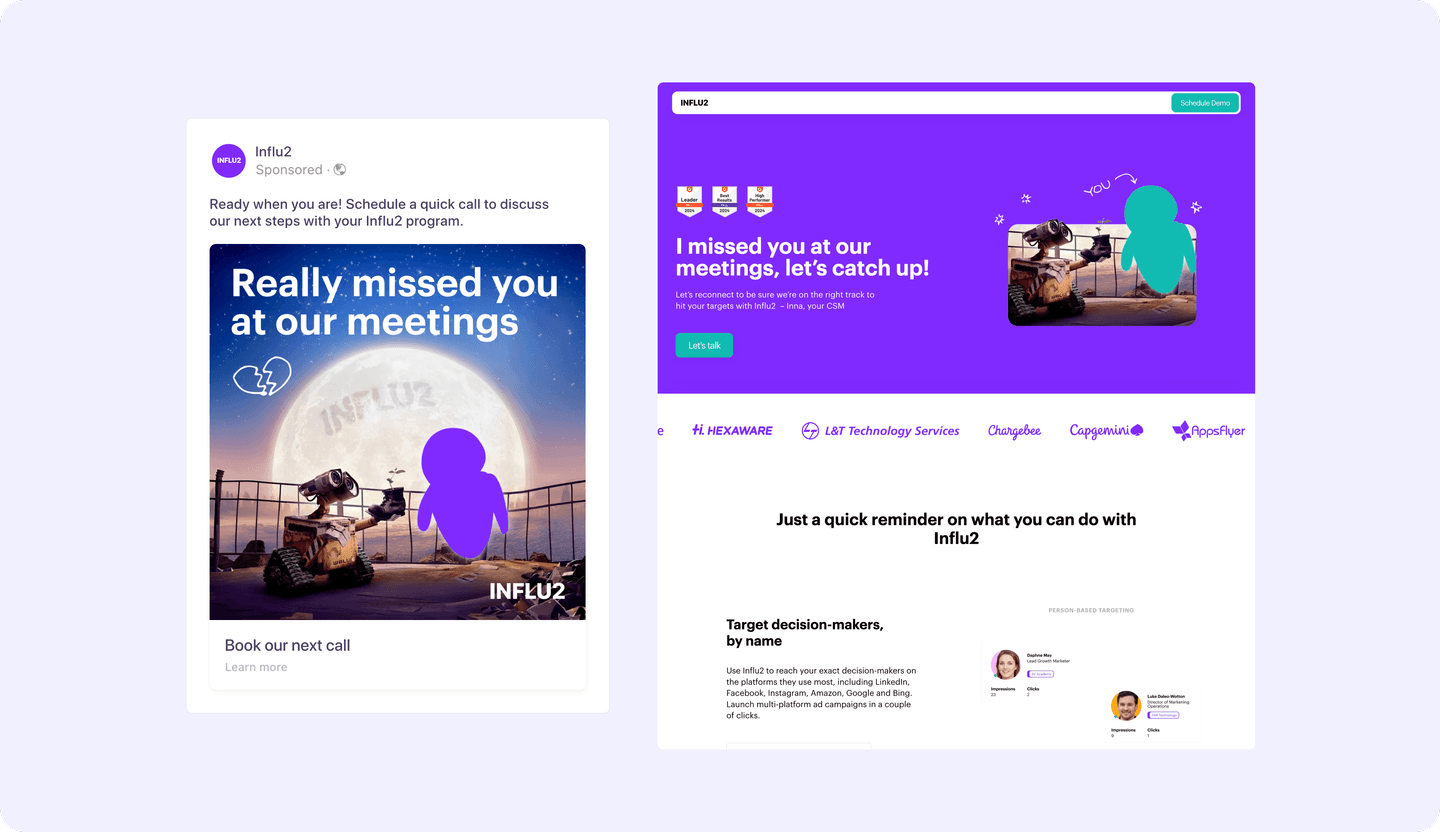
Getting users to log in
Once that initial onboarding meeting is complete, adoption is the name of the game, which starts by getting users to log in and get set up.
Social proof is a good lever to use in this case.
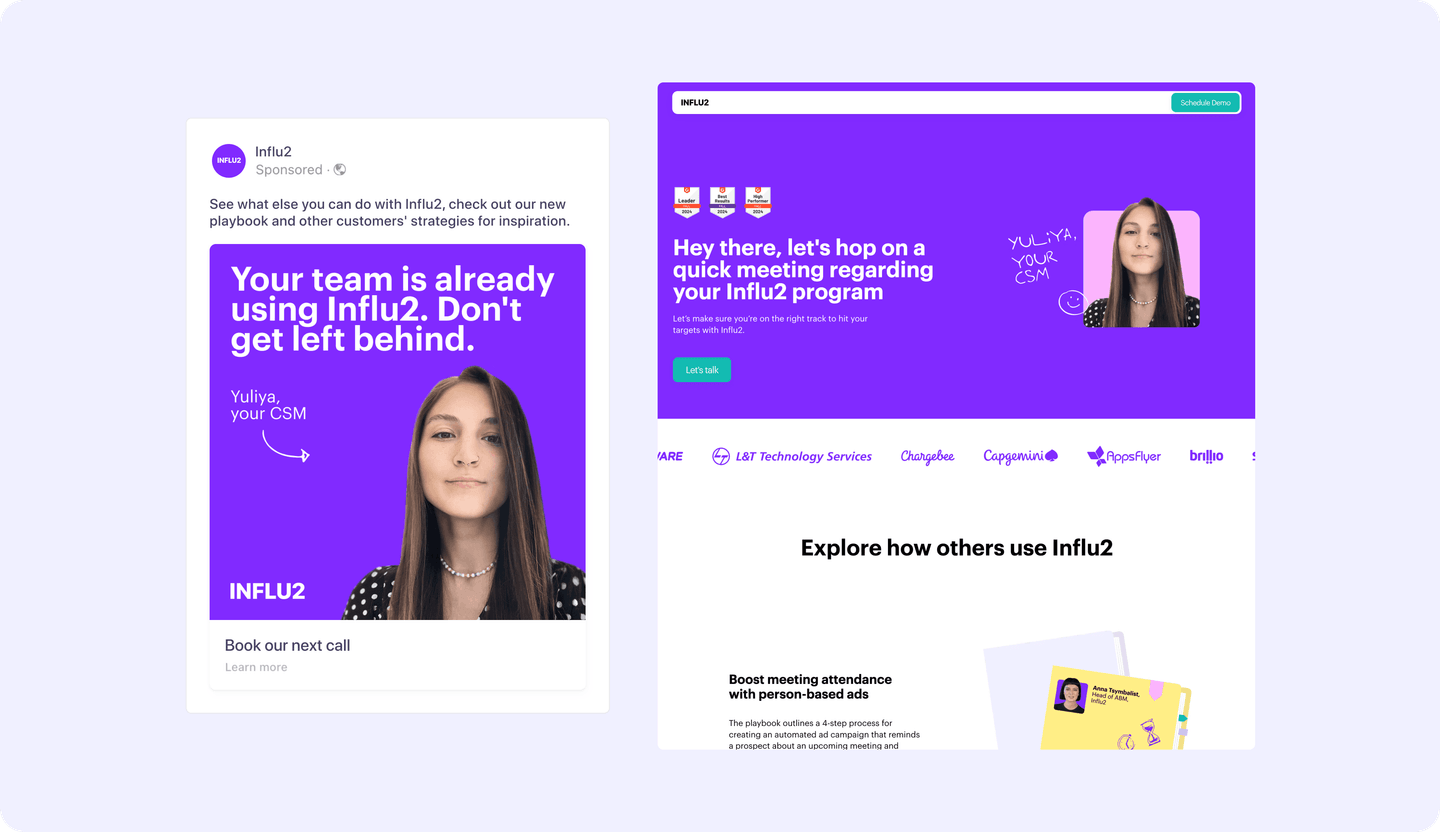
Capturing customer feedback survey
You can help CS understand what customers think of the onboarding process by promoting a simple survey.
In this case, you’d use a time-based trigger, such as “90 days after initial onboarding meeting.”
Focus on the metrics that matter
Given that your primary goal here is to support Customer Success, it's natural that you should align your success measurements with what they’re already using.
These are most likely Churn Rate, Net Revenue Retention (NRR), and Customer Lifetime Value (LTV).
If your retention program is working well, these three metrics should improve.
From there, you’ll want to look at campaign performance feeding up into those primary goals, including:
- Account coverage: What percentage of accounts are engaging with these programs over the course of a year?
- Contact-level coverage: Who in an account is engaging with your content? How often? And with how many different pieces of content?
- Engagement: What kinds of views and clicks is each program generating and how does this engagement correlate with improvements in churn, NRR, and LTV?
Customer sentiment metrics should round out your reporting suite. Use NPS or CSAT surveys to capture how customers feel about your brand and product.
These are not only an important retention/churn indicator (satisfied customers stick around), but they are also useful for tracking the impact of your churn prevention campaigns.
Don’t boil the ocean
For SaaS and subscription businesses, retention shouldn’t be an afterthought left for Success to solve. It should be an organization-wide focus, and Marketing should play a collaborative role in minimizing churn.
But there’s no need to get hypercomplex when designing your first retention marketing model. That’s a surefire way to land the project in the too-hard basket.
Instead, start with what you’re already doing (e.g., share your acquisition-focused education content with existing customers).
Then, slowly mature the program from there, adding in pre-determined sequences for specific lifecycle stages (such as onboarding) or creating personalized feature adoption campaigns.
The same goes for data quality.
If you want to be really proactive with churn prevention, you need a good churn-signalling model, but this can be resource-intensive to produce.
As a starting point, you can use a simple traffic light system to track customer sentiment (using CSAT or NPS as the data-gathering mechanism).
When a customer moves from green to yellow, that’s a signal for the CSM to jump in and uncover what’s behind that drop in satisfaction. From there, Success can team up with Marketing to run an appropriate playbook.
Then, work on maturing your model over time, integrating signals such as:
- Product usage metrics: Are they logging in? Are sessions increasing or decreasing?
- Engagement metrics: Are they engaging with your content? Are they attending meetings?
- Competitive signals: Has a key stakeholder left the company? Are they talking about or researching competitors online?







